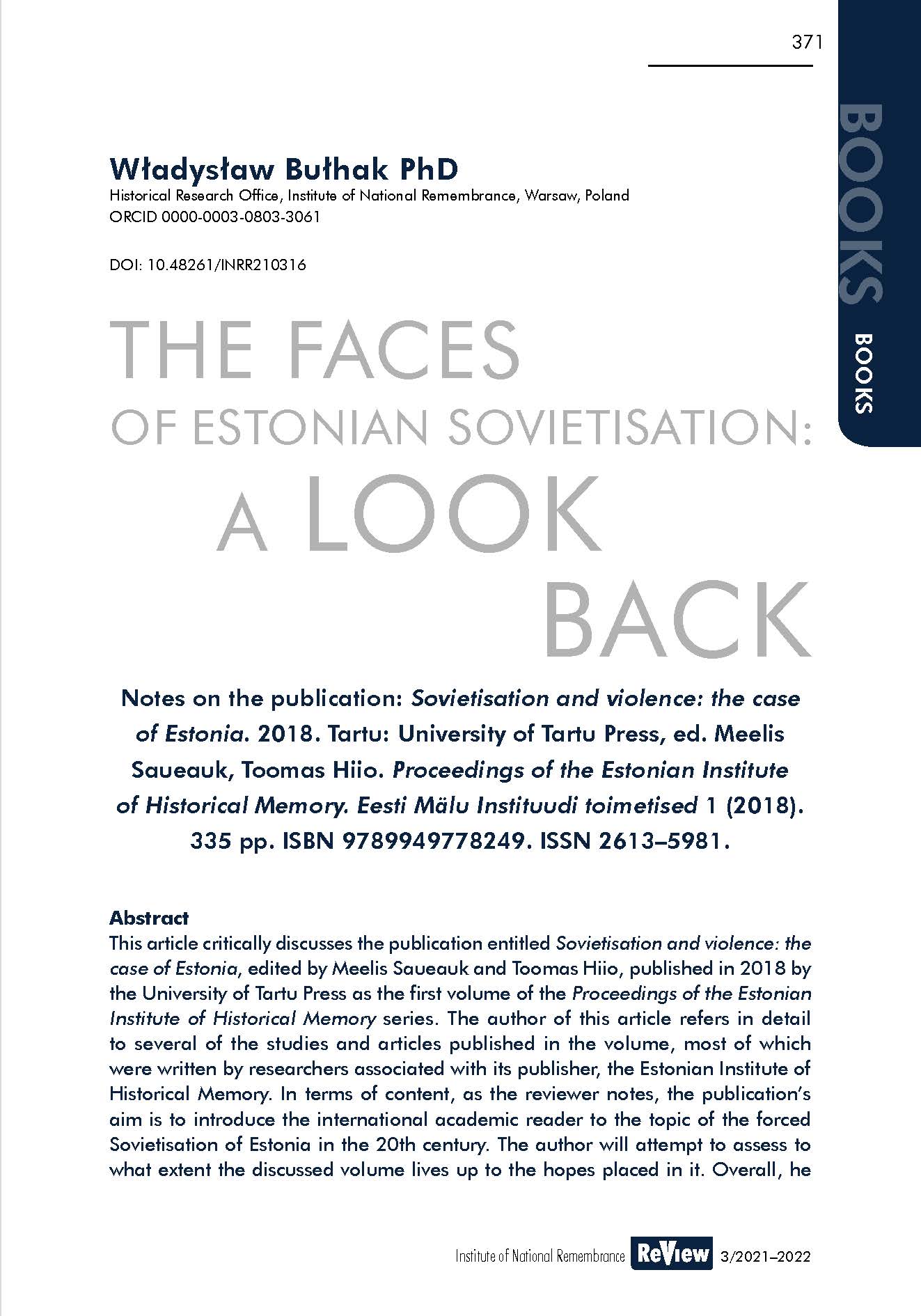Władysław Bułhak PhD
Historical Research Office, Institute of National Remembrance, Warsaw, Poland
ORCID 0000-0003-0803-3061
DOI: 10.48261/INRR210316
The Faces of Estonian Sovietisation: A Look Back. Notes on the publication: Sovietisation and violence: the case of Estonia. 2018. Tartu: University of Tartu Press, ed. Meelis Saueauk, Toomas Hiio. Proceedings of the Estonian Institute of Historical Memory. Eesti Mälu Instituudi toimetised 1 (2018). 335 pp. ISBN 9789949778249. ISSN 2613–5981.
Keywords: Sovietisation, Sovietisation and violence, Communism, Estonia, Estonian history 1917–1990, forced resettlement, Estonian political emigration, active measures, Communist repression apparatus, security apparatus, CPSU, Communist Party of the Soviet Union, Estonian Communist Party, Soviet occupation, Baltic countries, south Scandinavia
Abstract: This article critically discusses the publication entitled Sovietisation and violence: the case of Estonia, edited by Meelis Saueauk and Toomas Hiio, published in 2018 by the University of Tartu Press as the first volume of the Proceedings of the Estonian Institute of Historical Memory series. The author of this article refers in detail to several of the studies and articles published in the volume, most of which were written by researchers associated with its publisher, the Estonian Institute of Historical Memory. In terms of content, as the reviewer notes, the publication’s aim is to introduce the international academic reader to the topic of the forced Sovietisation of Estonia in the 20th century. The author will attempt to assess to what extent the discussed volume lives up to the hopes placed in it. Overall, he concludes that despite all the errors and omissions noted, the publication’s desired aim was achieved, while also showing the above-named institution’s potential as a scholarly research unit with ambitions reaching beyond the local academic market.
References
Ahonen, Pertti, Corni, Gustavo, Kochanowski, Jerzy, Schultze, Reiner, Stark, Tamás and Stelzl-Marx, Barbara. 2008. People on the Move. Forced Population Movement in Europe in the Second World War and its Aftermath. Oxford: Berg Publishers.
Die Sowjetisierung Ost-Mitteleuropas. Ed. Ernst Birke, Rudolf Neumann. 1959. Frankfurt: Metzner.
Bolschewisierung: was heißt das in Wirklichkeit? 1943. Berlin: Nibelungen Verlag.
Bułhak, Władysław. 2019. Wywiad PRL a Watykan [The Polish People’s Republic Intelligence and the Vatican]. Warsaw: Instytut Pamięci Narodowej-Komisja Ścigania Zbrodni przeciwko Narodowi Polskiemu.
Gross, Jan Tomasz. 1988. Revolution from Abroad: The Soviet Conquest of Poland’s Western Ukraine and Western Belorussia. Princeton: Princeton University Press.
The Baltic Question during the Cold War. Eds. John Hiden, Vahur Made and David J Smith. Abington: Routledge.
Kucharzewski, Jan. 1923–1935. Od białego caratu do czerwonego [From white Tsardom to the red one] vol. 1–7. Warsaw: Kasa im. Józefa Mianowskiego – Fundacja Popierania Nauki.
Kucharzewski, Jan. 1948. The Origins of Modern Russia. New York: SAND.
Lemke, Michael. 1999. ‘Einleitung’, in Sowjetisierung und Eigenständikeit in der SDZ/DDR (1945–1953). Ed. Michael Lemke. Köln: Böhlau.
Mozokhin, Oleg [Мозохин, Олег]. ‘История отечественных спецслужб и правоохранительных органов’ [History of the Homeland’s Special Services and Law and Order Enforcement]. shieldandsword.mozohin.ru. Accessed September 22, 2020. http://shieldandsword.mozohin.ru/.
Noskova, Albina Fyodorovna [Носкова, Альбина Федоровна]. 2005. ‘Na drodze do stworzenia PKWN – rola Moskwy’ [On the way to the creation of the PKVN: the role of Moscow]. Pamięć i Sprawiedliwość 2 (8): 31–49.
Petrov, Nikita. [Петров, Никита]. 2011. По сценарию Сталина: роль органов НКВД-МГБ СССР в советизации стран Центральной и Восточной Европы. 1945–1953 гг. [According to the Stalin’s script: the role of the NKVD-MGB of the Soviet Union bodies in the Sovietisation of the countries of Central and Eastern Europe 1941–1953]. Moscow. Accessed June 26, 2021. http://test8.dlibrary.org/ru/nodes/1364-po-stsenariyustalina-rol-organov-nkvd-mgb-sssr-v-sovetizatsii-strantsentralnoy-i-vostochnoy-evropy-1945-1953-gg.
Pucci, Molly. 2020. Security Empire. The Secret Police in Communist Eastern Europe. New Haven and London: Yale University Press.
Selvage, Douglas. 2014. “Operacja ‘Synonim’: czechosłowacki aparat bezpieczeństwa, środki aktywne bloku sowieckiego i proces KBWE (1976–1983)” [Operation Synonym: the Czechoslovakian security apparatus, the Soviet bloc’s active measures and the CSCE trial (1976–1983)]. Pamięć i Sprawiedliwość 1 (23): 119–133.
Snyder, Timothy. 2010. Bloodlands: Europe between Hitler and Stalin. New York: Basic Books.
Triandafillov, Vladimir Kiriakovich [Триандафиллов, Владимир Кириакович]. 1994. The Nature of the Operations of Modern Armies. Ilford, Essex, England; Portland, OR, USA: Frank Cass. English translation of the Russian original: 1936. Характер операций современных армий. Moscow: Государственное военное издательство Наркомата обороны СССР.
Voren, Robert van. 2010. “Political Abuse of Psychiatry – An Historical Overview”. Schizophrenia Bulletin 36 (1): 33–35. DOI: https://doi.org/10.1093/schbul/sbp119.
НКВД-МВД СССР в борьбе с бандитизмом и вооруженным националистическим подпольем на Западной Украине, в Западной Белоруссии и Прибалтике (1939–1956): сборник документов [The NKVD-MVD of the USSR in the fight against banditry and the nationalist armed underground in western Ukraine, western Belarus and the Baltics (1939–1956): collection of documents]. Eds. Vladimirtsev, N.I. [Н.И. Владимирцев], Kokurin A.I. [А.И. Кокурин]. 2008. Moscow: Объединенная редакция МВД России.
 E-Księgarnia
E-Księgarnia